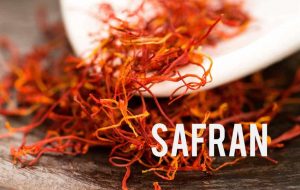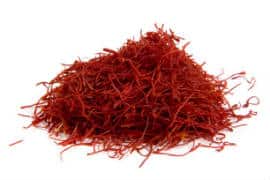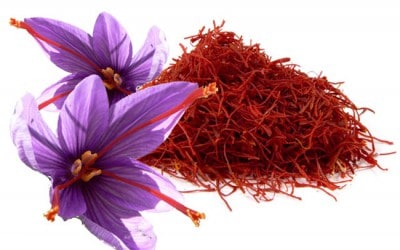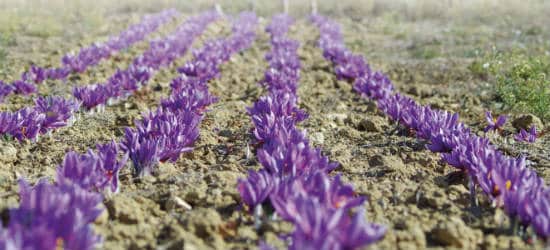A reliable source on many subjects.

A reliable source on many subjects.

![]()

A few orange-red filaments, an extraordinary fragrance and a taste that’s both sweet and powerful… Ladies and gentlemen, this is saffron, the most expensive spice in the world! Fortunately, nature has a way of doing things, as just a few filaments are enough to give off its subtle fragrance and give dishes a beautiful, bright, natural color.
Saffron has been around since antiquity, always considered a prestigious spice reserved for special occasions. It is also known for its medicinal properties, notably to improve states of anxiety and depression.
Scientific name : Crocus Sativus, it is probably the result of hybridization with other, older species, ultimately resulting in this beautiful mauve-colored flower with longer, reddish-orange pistils.

Common name : saffron
Origin: Saffron is described in ancient Greek, Persian and Iraqi literature.
The Pharaohs of Egypt left writings on their papyrus in which saffron is clearly recognized as having been used to purify ancient places of worship.
Saffron is widespread today, but is mainly grown in Iran, Spain and North Africa. Morocco produces saffron of excellent quality, but the quantity is still very small and barely sufficient for the needs of the local population.
This spice has long been known for its effect on the nervous system and prevention of stress-related and degenerative diseases. Here’s a closer look at what it can do for our bodies.
This is one of the most widely recognized properties. Among the Chinese, Indians and ancient Persians, saffron was used to improve mood swings and bouts of melancholy. Today, saffron is compared by some to the famous Prozac, but without the latter’s side effects.
Medical studies have been conclusive about saffron’s efficacy in mild depression. It works in the same way as chemical antidepressants, acting directly on serotonin, the neurotransmitter most involved in mood regulation.
In Iran, now the world’s largest saffron producer, a university study has demonstrated the spice’s action in combating anxiety and apathetic states, which lead to a loss of desire and enthusiasm.
 Saffron has a global action on neuronal health. It delays the degeneration and destruction of nerve cells. This is why it is believed to help delay Alzheimer’s disease and limit age-related degeneration.
Saffron has a global action on neuronal health. It delays the degeneration and destruction of nerve cells. This is why it is believed to help delay Alzheimer’s disease and limit age-related degeneration.
Saffron is renowned among students as a memory ally: it helps to record information more efficiently and improves learning capacity.
Saffron soothes joints and reduces menstrual pain. Its antispasmodic effect also calms intestinal pain.
Babies’ teething troubles are always treated with saffron, which is massaged into the swollen gums. Saffron-based syrups, known for over a century, are still used today to soothe toothache.
Saffron’s action on anxiety and mood, as well as physical and psychological fatigue, helps reduce stress factors that interfere with sleep.
A mild, almost pleasant sedative action helps you fall asleep and recover better the next day. This is why saffron is also, and almost paradoxically, renowned for its tonic effect, which helps restore energy to face the new day.
Saffron’s effect on serotonin regulation helps combat insomnia, as this hormone is involved in the central nervous system’s management of sleep.
It’s a fact that saffron helps you lose weight in a healthy, balanced way, as it limits snacking. Its mood-enhancing effect helps curb psychological cravings. It also controls appetite through its action on serotonin.
In traditional Indian and Chinese medicine, saffron is considered an adaptogen, meaning that it can adapt to the body’s needs.
Saffron acts as an appetite suppressant for compulsive snackers. On the other hand, in a healthy person, saffron’s slightly bitter taste can stimulate the appetite to a reasonable extent.
The pigments in saffron stimulate and facilitate digestion, by boosting the secretion of liver enzymes. These pigments also limit fermentation in the intestine.
However, scientists have yet to validate the effect on liver protection against excess alcohol.
One of saffron’s best-known uses is to stimulate libido and sexual desire. Perhaps this explains its high price? Who knows?
On the one hand, saffron has a euphoric effect by counteracting stress and anxiety. On the other hand, a slight effect on blood vessel dilatation enables the sexual organs to function better, in the same way in men as in women.
Saffron has also been suggested to have a positive effect on male fertility, improving sperm count and mobility.

Saffron fields, Taliouine region, Morocco.
Saffron’s red pigments have strong antioxidant properties, and could effectively combat the proliferation of free radicals and reduce the development of tumor cells.
This spice is not expensive for nothing, giving rice or chicken dishes an incomparable taste, as well as a very appetizing color. It is often used on its own, as many connoisseurs consider it a gastronomic crime to mix it with other spices that might mask its taste! I remember a rather interesting dish I tried on a trip to North Africa: saffron chicken.
Fortunately, a few filaments are all you need to get the taste and color. That’s why you should always use saffron in its raw state, neither ground nor mixed, and above all never look for cheap saffron: it simply doesn’t exist!
Saffron’s properties are the result of its formula, which is rich in antioxidant pigments and vitamins.
Freshly harvested saffron is not consumed immediately. It must undergo a gentle, carefully monitored drying process. This process develops more aromas and transforms certain components into more potent volatile oils.
Carotenoids
Saffron contains several types of carotene pigments, which give it its flavor, color and aroma.
Crocine and picrocine give saffron its color, and are transformed by heat into other volatile compounds.
Once purchased, saffron must be stored in a cool, dark place to preserve its olfactory properties.
Safranal, a volatile compound developed during the drying process, gives saffron its typical bitter flavor.
Saffron flowers are rarely used, yet they contain flavonoids and pigments with strong antioxidant properties. It is used by connoisseurs and lovers of saffron, who never miss a morsel of the benefits of this delicate and rare plant.
As saffron is consumed in very small quantities, the vitamins and minerals it contains cannot be considered sufficient for optimal use.
Saffron can be used as a spice by rubbing a few pistils or mixing them in hot water, which is no more than 1/10 of a gram.
For a therapeutic effect, half a gram of saffron pistils is enough for a large cup of herbal tea.
The cost of saffron is often the reason for using a small quantity for different purposes, which represents a benefit, as high doses of saffron are not recommended and are even dangerous.
For chronic supplementation, we recommend taking 15 mg of saffron twice a day. This is the upper limit recommended for long-term supplementation.
Preliminary data suggest that doubling this dose may have a toxic effect after eight weeks of continuous use.
Saffron can be taken twice a day as a supplement, or with meals as a spice.
Otherwise, single doses of saffron can reach 200mg.
Pregnant women should not treat themselves with saffron, as there is a real risk of abortion in the event of overdose.
In reality, overdoses are rare with saffron, as at around 30 euros a gram, you’re quickly dissuaded from using the whole bottle!
Saffron supplementation at higher-than-normal doses (over 200mg) in humans has been associated with alterations in blood and hemodynamic parameters which, although statistically significant, were not significant enough to be considered adverse.
Abnormal uterine bleeding was observed in two women taking doses of 200-400mg. [source]
Prolonged supplementation (26 weeks) with 60 mg saffron per day in men was associated with reduced red and white blood cell and platelet counts, a fall in systolic and diastolic blood pressure, and sedation and hypomania.
The researchers also noted changes in appetite, which began to occur after 8 weeks and increased substantially thereafter. [source]
Saffron extract is a very expensive ingredient. The average price of a supplement based on this extract is €30 per bottle. Some brands cost more.
For example Organic Saffron from Anastore which contains 15mg of pure saffron extract.
Its price is €37.00.
The bottle contains 60 capsules and covers a period of 2 months.
For every 3 bottles purchased, you’ll get the 4th free.